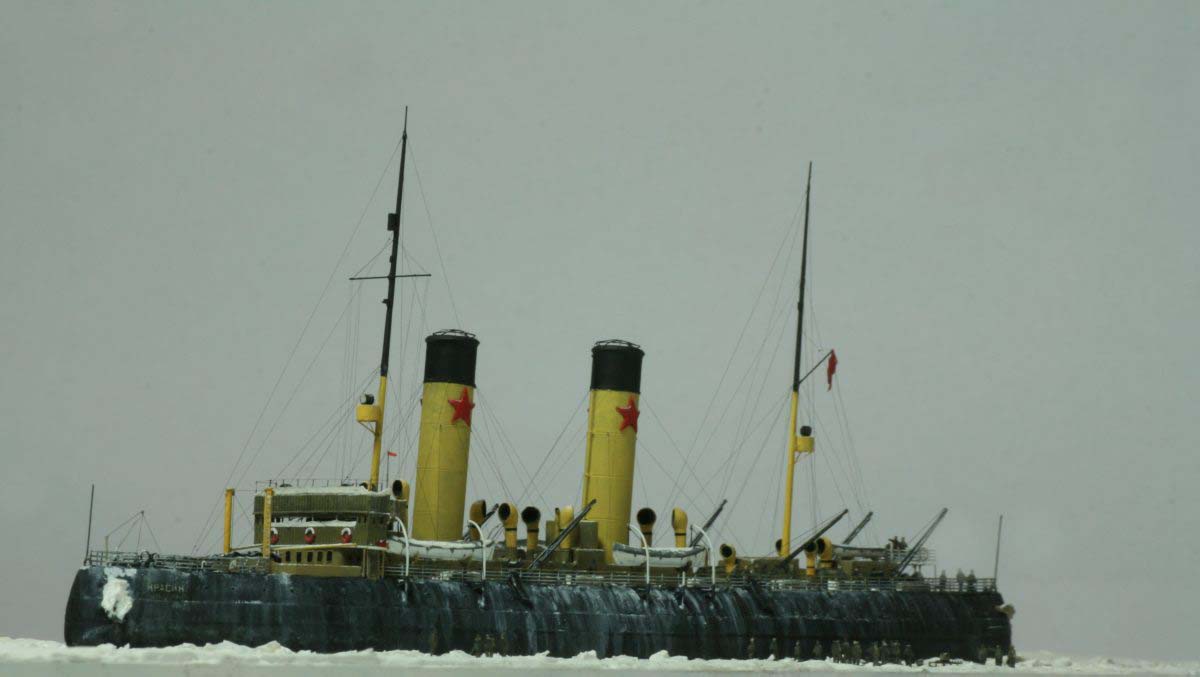
1/700 Icebrealer Krassin (Combrig/Scratchbuilt)
|
by Jim Baumann |

1/700 Icebrealer Krassin (Combrig/Scratchbuilt)
In 1917 Armstrong Whitworth delivered the icebreaker ship 'Sviatogor' to its Russian owners. The ship was built to the drawings of vice-Admiral. Makarov for the Russian Maritime Ministry. Until the early 1950s she remained the most powerful Icebreaker in the world. She was able to break and navigate in ice 4-5 meters thick
During the Civil War in Russia she was scuttled as a blockship. She
was seized by the Royal Navy on 03 August 1918, re-floated and then returned
to England for repairs. She was in service with the Royal Navy until 19
November 1921, when bought back by the Soviets, due largely to the efforts
of the People’s Commissar of Foreign Trade L.B. Krasin.
Upon his death in 1927 “Sviatogor” was renamed “Krassin” in his
honour. Krassin is best known for the rescue of the survivors of the crashed
polar exploration Airship Italia commanded by Umberto Nobile in 1928.
An massive international rescue effort was launched - the full story of which can be read here. On 25 July 1928 the German passenger vessel 'Monte Servantes' with 1835 persons on board collided with an iceberg and suffered severe hull damage; Krassin came to the rescue and escorted the damaged vessel to Spitzbergen. In 1933 she made a winter voyage to the north of Novoja Zemlja the first ever winter voyage to that latitude. In 1934 she searched for the trapped crew of the steamer Cheluskin, which was crushed by the ice and lost. Krassin found rescued the marooned crew from the ice. In 1938, the Krassin rescued the Icebreaker Lenin and her convoy, which had been trapped in the ice at the end of the previous summer.
On 18 July 1941, the U.S. Secretary of the Treasury, Henry Morgenthau, wrote to the Acting Secretary of State Sumner Welles: "In order to meet the immediate needs of this country it is recommended that negotiations be entered into with the Russian Government for the purchase of one or more of their modern ice breakers”. In the fall of 1941 Krassin arrived at Bremerton Navy Yard and a Coast Guard party surveyed her. She required considerable investment for refit for US service and the funds had been allocated. Pressing strategic issues in Northern Russia however terminated the leasing arrangement and she was to return to home waters.
Although the Krassin never joined the Coast Guard, the USA learned about icebreakers and their characteristics from studying her design. That knowledge was put to good use in the design of the US Coast Guard's Wind-Class icebreakers that saw service towards the latter part of World War II. In 1942 en route from the USA she stopped in Great Britain where she was armed with surface and anti-aircraft guns, thereafter steaming to Reykjavik, Iceland where she joined convoy PQ-15. She escorted the convoy through the North and Barents Seas, around the Kola Peninsula and into Murmansk.
She was thereafter used to keep the Northerly routes open and escorting Russian and Allied ships with war supplies in the Arctic. She survived the war but was rather worn out. In 1957 she was extensively re-built and refitted in East Germanys’ Matthias Thesen yard, receiving all new machinery and her external appearance changed considerably. Her superstructure was modernised and was fitted with a small streamlined funnel. From 1958 until 1972 she continued her service used in Arctic waters, based at Murmansk. She was thereafter converted into a research vessel—her outer shafts and machinery being removed and renamed Leonid Krassin, carrying out research work in the Arctic. In 1974 she was removed from service as a research vessel and used as a floating Power station at Spitsbergen. In 1977 she was moved to Franz Joseph Island and continued in her role as a floating electricity generator. 1986 to 1989 she was again in service used as a research vessel. 1990 she made goodwill courtesy round-trip to Hamburg, Rotterdam and London; returning via Copenhagen to Leningrad. She was due to be scrapped; however a former captain of the vessel, Capt. L.Burak and a group of volunteers saved the ship from being dismantled. She is moored alongside in St Petersburg and is open to the public as a floating museum with 700 objects in its collection.
The model…
---------------
The model was to be a ‘simple’ build of the kit by Kombrig…
However the kit was based on somewhat flawed plans. In the end the hull
only was used a resin blank which received extensive reshaping, being made
taller, a little wider with far more pronounced tumblehome. The casting
was lacking any planking detail and was re-decked.
All new superstructure, hatches and funnels being entirely scratch-built of brass, styrene sheet and paper; the illustrated trials and tribulations thereof can be read here. I portrayed my model around 1932- at that point the upper level of the bridge was Enclosed with solid timber panelling and the radio shack moved ahead of the aft funnel. —The platforms and crows-nests also changed position from the 1928 and as built versions.
In conclusion it was a most interesting build – being educational and
broadening my horizons in both subject matter and techniques.
